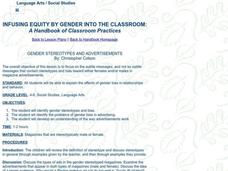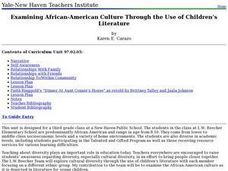Curated OER
Cliques Online
Learners develop critical thinking skills about personal situations depicted in a video about cliques. Issues about identity, self-esteem, and stereotypes are explored.
Curated OER
Say It Loud!: A Celebration Of Black Music In America
Students examine the role music played in African American history and research events of the Civil Rights movement.
Curated OER
THE GOOD AND THE BADDE: ARE STEREOTYPES A PERFECT FIT?
Students examine stereotypes of women from The Good and the Badde in juxtaposition with the female characters in The Taming of the Shrew. Through this exercise, students locate evidence from the text of the play to support or refute...
Curated OER
Stories of Individuals in the Chinese Community: a Comparative Approach
Students focus on stories describing the experiences of several individuals in the Chinese community and compare them with the experiences of Chinese immigrants in the late 20th century.
Ed Change
Circles of My Multicultural Self
Learners identify what they consider to be the most important dimensions of their own identity, and examine stereotypes.
Curated OER
Respect, Prejudice, and Race
Students' examine their opinions about respect, race, and stereotypes and their beliefs as a group. They complete a short questionnaire and then write an essay on reducing prejudice and discrimination.
Curated OER
A (Class)Room of One's Own
Students assess the educational and social issues of boys and girls in school as a springboard to interviewing women in the fields of science, in order to study of their early interests and experiences in these typically male-dominated...
Curated OER
Recognizing Bias
This PowerPoint outlines methods for recognizing bias in various forms of media. The presentation defines loaded words, stereotypes, and one-sided arguments as types of bias and also highlights the characteristics of facts and opinions.
Curated OER
Confronting the -Isms
Students keep "Mindwatch" diaries to chart their own prejudices and stereotypes. In this social justice lesson, students monitor their own reactions to people who are different from themselves. Students identify and discuss patterns of...
Curated OER
Guidelines for Recognizing Persuasiveness, Propaganda, and Stereotypes
Students investigate advertisements for examples of persuasiveness, propaganda, and stereotypes. In this persuasion lesson, students find examples of advertisements that are unusual or common. Students discuss guidelines for...
Curated OER
Diversity - Grade 8
Eighth graders consider the diversity of the First Nations cultures in Canada. In this cultural diversity lesson, 8th graders research the cultural groups of the First Nations as well as their contributions to Canadian society. Students...
Curated OER
Diversity - Grade 7
Seventh graders consider the diversity of the First Nations cultures in Canada. For this cultural diversity lesson, 7th graders research the cultural groups of the First Nations as well as their contributions to Canadian society....
Curated OER
Diversity - Grade 9
Ninth graders consider the diversity of the First Nations cultures in Canada. In this cultural diversity lesson, 9th graders research the cultural groups of the First Nations and share their findings with their classmates.
Curated OER
When Johnny Came Marching Home
Students examine the concept of gender bias. In this discrimination activity, students research 1940's and 1950's America and determine how historical events shaped the changing role of women in the country.
Curated OER
Introducing the Victims of the Holocaust
Students consider the plight of Holocaust victims. For this World War II lesson, students discuss the number of Jews who were persecuted during the war and read biographies by Holocaust survivors. Students compose essays on personal...
Curated OER
Infusing Equity by Gender into the Classroom
Young scholars identify gender stereotypes in magazine advertisements. In this gender bias lesson plan, students discuss the problems of gender bias in advertising and develop an understanding of the way advertisements work.
Curated OER
Japanese Culture
Ninth graders examine the differences in the way genders have been treated in the same society over the course of a nation's history. In this World History lesson, 9th graders study the factors that have caused changes in stereotyping...
Curated OER
Diversity: Using Light to Filter Prejudices
High schoolers use physics to discuss diversity. In this social interaction lesson, students use their knowledge of colors and filters to relate it to stereotyping and prejudices.
Curated OER
Needs of the Homeless
Learners explore the needs of the homeless. For this philanthropy lesson student read chapter 1 of Trevor's Place and discuss facts regarding homelessness. Students write their impressions about homelessness in journals.
Curated OER
We Are One World
Students examine discrimination, prejudice, and bias in the world. In this tolerance lesson, students research examples of prejudice in different countries. They then identify the Core Democratic Values in song lyrics. Students locate on...
Curated OER
Maniac McGee, Lesson 3
Students explore possible causes of stereotyping. In this multicultural awareness lesson, students participate in activities in which "conditioning" affects responses. Students compare their conditioned responses to possible community...
Curated OER
New Movements For Social Justice: The Latino Struggle for Equal Rights
Students examine myths and stereotypes about Hispanic immigrant groups. They appreciate and share the strengths of their diversity and view films that challenge ideas about education and cultural values. They explore the Latino Rights...
Curated OER
Research Methods
Students identify the strengths and weaknesses of various family forms: living alone, couples without children, couples with children, divorced adults, traditional families, single-parent families, blended families, etc. They assess...
Curated OER
Children's Literature and African American Culture
Third graders examine various stories and poems and identify characteristics that make each individual unique. After analyzing the readings, they create their own personality poems to accompany self-portrait drawings. The poems and...

























